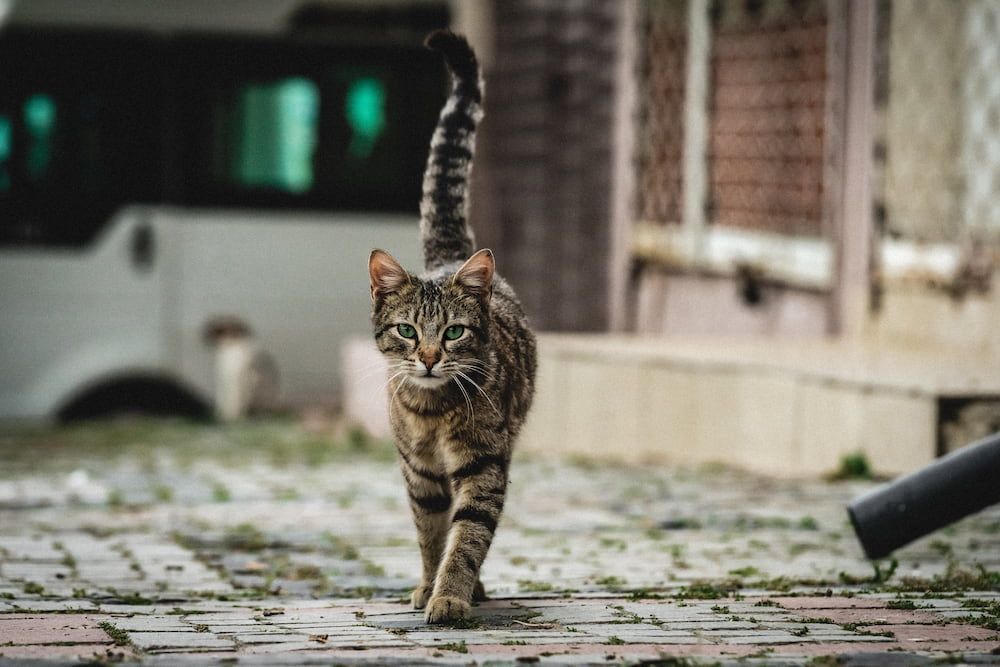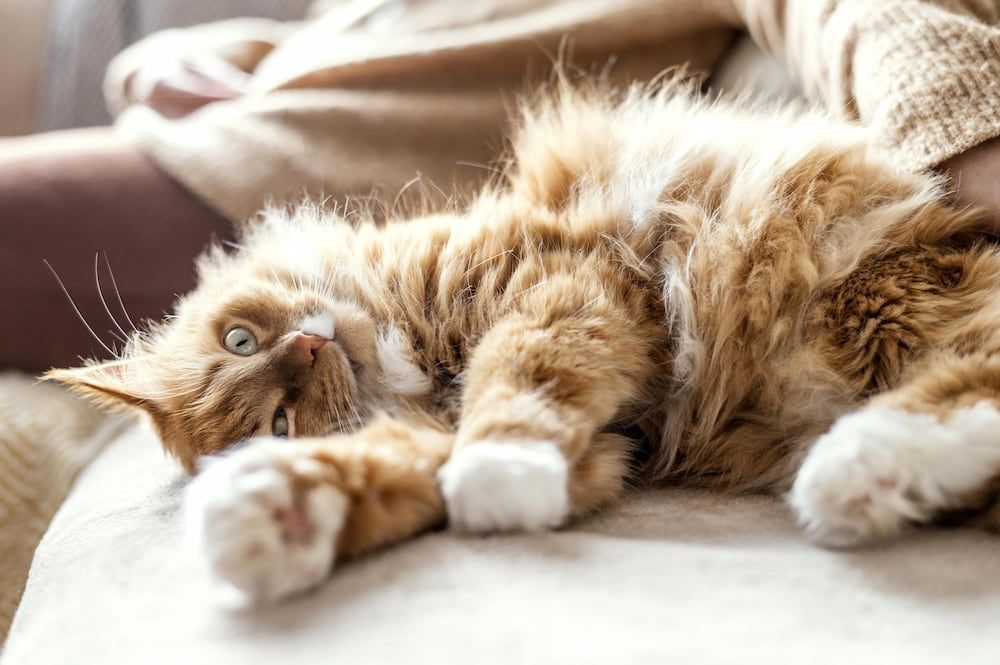Indoor vs Outdoor Cats: Should we let our cats roam?
Written by:
Author: Marissa Prizio
Marissa Prizio attended the University of New Hampshire and earned a bachelor's degree in biomedical Animal Science. Marissa has always enjoyed writing; she was even mixing literature classes into her science major in college. During her writing career, she has edited eBooks, written for a variety of websites, and created audio-visual courses for sustainability.
View all 36 articlesLearn about our editorial process and veterinary review board.
Viewed: 67
Updated on: 12/23/2022
Cats have retained some wild characteristics despite thousands of years of domestication. Unlike other species of domesticated animals, they still have a strong prey drive and engage in behaviors that make them appear like small wild animals. These behaviors have led to one of the most significant conflicts for the modern pet owner, indoor vs outdoor cats.
Cats are so fascinated by all the engaging elements of the outside world that their curiosity is difficult to ignore. It is usual for loving pet parents to want to offer their pets a fulfilling life full of adventure, but is an outdoor life best for your kitty? Let’s explore all outdoor and indoor life has to entail so you can best accommodate your feline friend’s needs.
Should I let my indoor cat roam outside?
Most professionals recommend keeping pets indoors. Many domesticated pets can hunt and protect themselves to some degree, but the outside world is dangerous. Domestic pets, especially those born and raised indoors, are not equipped to take on the outside world.
If your new friend is a curious feline drawn to the outdoors, there are safe ways to give them the entertainment they crave. Supervised outdoor time provides the best of both worlds by entertaining your pet while protecting your pet’s health.
Other animals also benefit from your pet not being allowed to free roam outside. Research has found that cats impact many native species in countries around the globe. Native wildlife like birds, small reptiles, and rodents that help natural support ecosystems can be depleted by unchecked outdoor pets. [2]
Health Concerns of Letting a Cat Outdoors
Health issues are one of the biggest reasons outdoor living is not recommended for cats. [1] An outdoor kitty faces significantly more threats than other pets who are safe in their homes. Anything can happen to an unsupervised outdoor pet, but here are some of the most common health concerns owners need to be aware of.
Feline Leukemia Virus
FeLV is a highly contagious infectious disease spread among pets through saliva, milk, urine, feces, and the mucus of infected animals. This disease can lead to cancer, immunodeficiency, and blood disorders and make animals extremely susceptible to infections they would otherwise survive. The intensity and symptoms of this FeLV can wax and wane, but it can not be cured. [3]
Infected cats have to live with this infection and can spread it to other healthy individuals. Outdoor pets are at a much higher risk than indoor pets because they can be in direct contact with infected individuals. A FeLV vaccine can help prevent this disease, but like all vaccines, it is not a 100% guarantee that your pet won’t get infected if exposed. [3]
Unwanted Pregnancies
Pregnancy in cats may seem short and easy, but it is often complicated and costly. Outdoor felines that are not fixed can quickly become pregnant or impregnate other pets. If your pet is impregnating other pets, you may not deal with the immediate effects, but you should know they contribute to problems with existing feral cat populations.
If your unfixed outdoor cat gets pregnant, you must take on the responsibilities of associated medical care and the expenses that come with it. Some diseases pets can pick up can cause damage to the developing kittens, and fatal problems can occur during birth.
Even if your pet and its kittens survive, you must rehouse them responsibly. This can be very difficult, considering that most shelters are already packed with pets, and a single litter can consist of up to 12 kittens.
READ MORE: How to tell if a Cat is Pregnant?
Rabies
Rabies is a serious concern for outdoor pets. This zoonotic disease is deadly to mammals and easily transmitted through bites and scratches from pets or other infected animals. [4]There is a rabies vaccine but no cure if an unvaccinated animal or person is infected.
It can take time for rabies symptoms to show, but an animal can still spread the disease during that time. A veterinarian should immediately assess cats returning from unsupervised adventures with mysterious bites or wounds. If they are unvaccinated, a quarantine period may be necessary, and if they injure a person, things can get much more complicated. [4]
Parasites
Cats have a tendency to always appear clean and groom themselves regularly, but this does not make them immune to parasites. Cats can bring home a number of parasites, many of which can shorten their lives and cause pain. Some parasites that pets can pick up outdoors can even be transmitted to humans.
- Ticks
- Fleas
- Heartworm
- Roundworms
- Tapeworms
- Lungworms
- Giardia
Some of the parasites listed prior can be prevented or treated at the very least. [1] Heartworm medications are available for pets, but there are no safe treatment options for a vat that does get infected with heartworms. This means heartworms can be fatal, and outdoor pets are at a very high risk since they are regularly exposed to the mosquitos which spread this parasite.
Feline Panleukopenia
Feline Panleukopenia is also known as feline distemper. This virus is hard to call and can persist in the environment, making it difficult to avoid. Most pets are exposed to this virus at some point in their lives and healthy adult animals can survive it in most cases. This virus is normally fatal for sick, old, or very young cats. [5]
Vaccination can help prevent infection with Feline Panleukopenia, but the best prevention is keeping pets in an environment that has not been contaminated. [5]
Feline Infectious Peritonitis
FIP, or feline immunodeficiency virus, is another deadly feline-specific virus that is transmitted between pets. This virus mutates in some cats, resulting in an immune response that is often fatal even with supportive care. [6]
There is currently no approved treatment for this virus, and the FIP vaccine is not considered entirely effective. [6] Like most other infectious diseases, the best prevention for FIP is avoiding interactions with possibly infected individuals.
Traumatic injuries and wounds
The outdoors can be intense and unpredictable. Cats have to evade wild threats, negative interactions with other outdoor pets, and man-made dangers. Even well fed cats may not return home if left outdoors unattended. They could be hit by a car or end up with other injuries that prevent them from returning home. If you don’t know where your kitty is outside, it becomes impossible to find them when they need help.
Are some cats naturally indoor or outdoor cats?
Cats are individuals with different tendencies which may make some pets seem bolder and more comfortable outdoors than others. Indoor cats tend to gaze out the window at the world outside, but that doesn’t mean they hate their indoor environment. Cats can enjoy being indoors as long as they are entertained with toys.
If owners truly feel their pets will benefit from some fresh air, the best way they can introduce the outdoors is with supervision. Pet leashes and securely enclosed areas allow pets to enjoy the stimulation that the outdoors provides without all of the risks. [1]
READ MORE: Best Cat Harness
Pros and cons of letting a cat outside
At face value, letting a pet outdoors has many pros. They can seek out their own entertainment, pets scratch on trees instead of your furniture, you have to clean the litterbox less since they generally prefer to go outdoors, and if you have three cats or more it can provide them with more space.
The pros surely are tempting, but they do not outweigh the cons of outdoor life. Outdoor cats face a shorter life expectancy due to their increased disease exposure and other dangers. There is also the chance that your pet may be picked up by animal control or a kind samaritan who knows the dangers of outdoor living and wants to provide them with a safe home.
If you want to prevent the health concerns that come with unsupervised outdoor time, then it makes sense to keep cats indoors.
How to help cats explore the outdoors safely
Keeping your cat indoors doesn’t have to exclude all outdoor activities. You can help your cat explore the outdoors if you get your feline friend a safe enclosed area or a leash.
Things like “catios” can combine your pet’s indoor environment with nature while still protecting them from wild animals. As long as you keep your pets inside a protected area or watch them closely with a method of control, like a leash, they can have plenty of fun outdoors. [1]
FAQ’s
Is it okay to have an indoor-outdoor cat?
Outdoor cats are at a greater risk for most health issues, which is why most veterinarians provide expert advice focused on them staying indoors. Your cat can still enjoy time outdoors, but it is best to do so in a cat safe way that is monitored. This indoor and controlled outdoor lifestyle is safest for your cat, your family, and the native wildlife. [2]
Are outside cats happier than inside cats?
Many cats need to be entertained and have their needs met to be in a healthy mental state. For some felines, a window seat is plenty of entertainment while others may try to venture outdoors. Regardless of whether a cat is indoor or outdoors, they can still fail to have their needs met in a way that keeps them happy.
Keeping your cat indoors can be a satisfactory lifestyle for your pet as long as you provide them with plenty of entertainment. Scratching posts, climbing towers, and other toys that allow your cat to engage in natural behaviors are key for a satisfied indoor cat.
What is the difference between indoor and outdoor cats?
The difference between indoor and outdoor cats is their owners. Domesticated cats have evolved to live with humans, and while their ancestors came from the great outdoors their survival isn’t guaranteed.
Owners make this decision for their cats since cats don’t know of the risks they face. If you decide not to keep your cat inside they will likely meet other animals, be exposed to danger, and contact diseases that will require more checkups and likely shorten their lifespan.
Article Sources:
- Williams, Krista, and Cheryl Yuill. “Cats and the Perils of Outdoor Living.” VCA Animal Hospital, vcahospitals.com/know-your-pet/cats-and-the-perils-of-outdoor-living.
- ”AVMA Speakers Discuss Outdoor Cats and Wildlife.” Merck Veterinary Manual, merckvetmanual.com/news/editorial/2019/09/30/14/04/avma-speakers-discuss-outdoor-cats-and-wildlife.
- ”Feline Leukemia Virus.” Cornell Feline Health Center, vet.cornell.edu/departments-centers-and-institutes/cornell-feline-health-center/health-information/feline-health-topics/feline-leukemia-virus.
- Weir, Malcolm, and Ernest Ward. “Rabies in Cats.” VCA Animal Hospital, vcahospitals.com/know-your-pet/rabies-in-cats.
- ”Feline Panleukopenia.” American Veterinary Medical Association, avma.org/resources-tools/pet-owners/petcare/feline-panleukopenia.
- ”Feline Infectious Peritonitis.” Cornell Feline Health Center, vet.cornell.edu/departments-centers-and-institutes/cornell-feline-health-center/health-information/feline-health-topics/feline-infectious-peritonitis.
 Cat Care Why Does My Cat Follow Me? Reasons Why Your Cat’s Following You Everywhere
Cat Care Why Does My Cat Follow Me? Reasons Why Your Cat’s Following You Everywhere - 181
- 0
 Cat Care Why Doesn’t My Cat Like to be Held? 8 Reasons Why And How to Change It
Cat Care Why Doesn’t My Cat Like to be Held? 8 Reasons Why And How to Change It - 2048
- 2
 Cat Care How High Can Cats Jump? All You Wanted to Know About Cats Jumping Abilities
Cat Care How High Can Cats Jump? All You Wanted to Know About Cats Jumping Abilities - 255
- 0
 Cat Care Can Cats Get Kennel Cough? Symptoms, Treatment and Prevention (Vet Approved)
Cat Care Can Cats Get Kennel Cough? Symptoms, Treatment and Prevention (Vet Approved) - 45
- 0
 Cat Veterinary Tips Cat Stomach Gurgling: Vet Advice on Why is Your Cat Stomach Gurgling?
Cat Veterinary Tips Cat Stomach Gurgling: Vet Advice on Why is Your Cat Stomach Gurgling? - 33732
- 4
 Cat Care Why Does My Cat Attack My Legs? 10 Reasons Why and What To Do About It (Vet-Approved Advice)
Cat Care Why Does My Cat Attack My Legs? 10 Reasons Why and What To Do About It (Vet-Approved Advice) - 45082
- 21
 Cat Veterinary Tips Cat Stomach Gurgling: Vet Advice on Why is Your Cat Stomach Gurgling?
Cat Veterinary Tips Cat Stomach Gurgling: Vet Advice on Why is Your Cat Stomach Gurgling? - 33732
- 4
 Cat Veterinary Tips My Cat Lost its Voice: Can Cats get Laryngitis? (Vet Advice)
Cat Veterinary Tips My Cat Lost its Voice: Can Cats get Laryngitis? (Vet Advice) - 22890
- 13





















